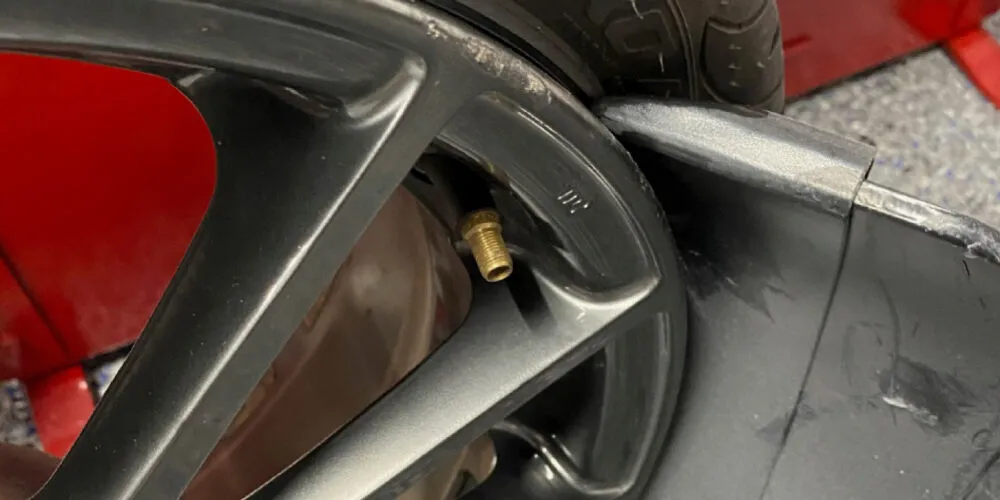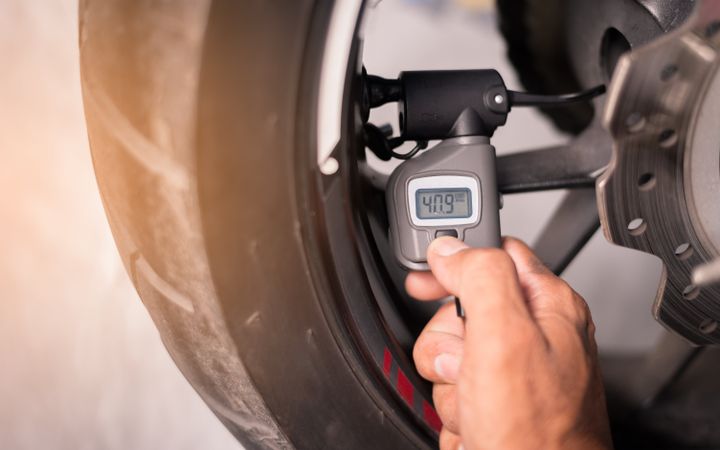


A Tire Pressure Monitoring System (TPMS) is an electronic system designed to monitor the air pressure in a vehicle's tires. It consists of sensors installed in each tire that transmit pressure data wirelessly to the vehicle's computer system. The primary purpose of TPMS is to alert the driver when one or more tires are underinflated, which can lead to poor fuel efficiency, uneven tire wear, and increased risk of a blowout or accident.

Before we dive into the main topic, let's take a moment to understand what TPMS sensors are and why they're so crucial. These tiny devices, typically mounted on each wheel, are designed to monitor the air pressure in your tires and transmit that information to your vehicle's computer system.
| Importance of Proper Tire Pressure |
|---|
| Safety: Underinflated or overinflated tires can compromise your vehicle's handling, braking performance, and overall stability, increasing the risk of accidents. |
| Fuel Efficiency: Improperly inflated tires create more rolling resistance, leading to higher fuel consumption and increased emissions. |
| Tire Wear: Uneven tire wear can occur when tires are not inflated to the correct pressure, reducing their lifespan and increasing replacement costs. |
When the tire pressure falls below or exceeds the recommended levels, a warning light illuminates on your dashboard, alerting you to potential tire issues.
While TPMS sensors are designed to be durable, they can fail due to various reasons. Here are some of the most common culprits:
TPMS sensors are powered by small, non-rechargeable batteries that typically last between 5 and 7 years. As the battery drains, the sensor may stop transmitting accurate pressure data or stop functioning altogether. This is often the primary reason for TPMS sensor replacement.
Potholes
Curb impacts
Improper tire service
These factors can cause physical damage to the TPMS sensors, such as bent or cracked sensor stems, leading to air leaks or complete sensor failure, necessitating replacement.
Over time, road salt, moisture, and dirt can corrode the sensor stem, leading to air leaks or sensor malfunction. This is particularly common in areas with harsh winter conditions or near coastal regions.
| Corrosion-Prone Environments |
|---|
| Areas with heavy road salt usage |
| Coastal regions with high humidity and salt air |
| Regions with frequent exposure to moisture and dirt |
If new TPMS sensors are installed but not properly relearned to the vehicle's computer system, the TPMS warning light may remain illuminated, indicating a fault. Proper relearning procedures are crucial to ensure the system functions correctly.
Before deciding whether to replace TPMS sensors, it's essential to perform a thorough inspection and diagnosis. Here are the steps I typically follow:
Visual Inspection
Carefully examine each sensor for signs of physical damage, corrosion, or air leaks.
TPMS Scan Tool
Use a specialized TPMS scan tool to activate each sensor.
Check the sensor's signal strength, identification number, and pressure reading.
Pressure Comparison
Compare the pressure readings from the TPMS scan tool to those obtained using an accurate tire pressure gauge.
Identify any faulty sensors by looking for mismatched readings.
OBD2 Scan
Connect an OBD2 scan tool to the vehicle's diagnostic port.
Check for any TPMS-related fault codes, which can provide valuable insights into the nature of the issue.
Common signs of TPMS sensor failure include:
| Signs of TPMS Sensor Failure |
|---|
| Flashing TPMS warning light (indicating a sensor fault or malfunction) |
| Continuously illuminated TPMS light (may indicate low tire pressure or a system fault) |
| No sensor detected by the TPMS tool (likely a dead battery or damaged sensor) |
| Mismatched pressure readings between the sensor and a manual gauge |
If a TPMS sensor is found to be faulty or nearing the end of its battery life, replacement is typically recommended. Here's a general overview of the repair process:
Sensor Removal
Deflate the tire and break the bead.
Access the sensor from the back of the wheel.
Carefully remove the old sensor and clean the mounting area.
New Sensor Installation
Securely install the new TPMS sensor in the mounting area.
Use a torque wrench to tighten it to the manufacturer's specifications.
Tire Reinstallation
Reinstall the tire and inflate it to the recommended pressure.
Relearning Procedure
Refer to the vehicle's service manual for the specific relearning method.
Common methods include manual relearn, OBD2 relearn, or using a TPMS trigger tool.
Properly relearn the new sensor IDs to the vehicle's computer system.
During tire service, it's also recommended to:
Replace any service parts like grommets, nuts, and valve caps.
Clean the sensor mounting area and use anti-seize on threaded components to prevent future corrosion and ensure proper sensor function.
Avoid using tire sealants, as they can clog and damage TPMS sensors.

While TPMS sensor replacement may be necessary in some cases, there are steps you can take to prevent or delay future issues:
Regular Maintenance
Check your tire pressures monthly and before long trips.
Replace TPMS sensors every 5-7 years or as recommended by the manufacturer.
Proper Usage
Avoid excessive speed over potholes or curb impacts that could damage sensors.
Use caution when airing up tires to prevent sensor stem damage.
Address TPMS warning lights promptly to prevent further issues.
Tire Rotations and Replacements
Have your TPMS sensors checked and relearned after tire rotations or replacements to ensure proper system functionality.
The cost of replacing TPMS sensors can vary depending on several factors, such as the vehicle make and model, the type of sensors used (OEM or aftermarket), and labor costs.
| Cost Breakdown |
|---|
| OEM TPMS Sensor: $50 - $150 per sensor |
| Aftermarket TPMS Sensor: $20 - $80 per sensor |
| TPMS Service Kit (grommets, nuts, etc.): $5 - $20 per wheel |
| Labor for Sensor Replacement (including relearning procedure): $50 - $150 per sensor |
Additionally, if you plan to diagnose and relearn the sensors yourself, you may need to purchase or rent a TPMS scan tool, which can cost anywhere from $100 to $500 or more, depending on the tool's capabilities.
It's generally recommended to replace all four TPMS sensors at the same time, as the batteries tend to deplete around the same period. This approach can help avoid having to replace them individually over a short period and ensure consistent performance across all tires.
In conclusion, while TPMS sensor replacement is not strictly required when getting new tires, it is often recommended, especially if the existing sensors are nearing the end of their expected battery life or showing signs of failure. Properly functioning TPMS sensors are crucial for maintaining correct tire pressures and ensuring safe vehicle operation.
As an automotive mechanic, I cannot stress enough the importance of addressing TPMS issues promptly. Ignoring warning lights or driving with improperly inflated tires can lead to:
Decreased fuel efficiency
Uneven tire wear
Potentially dangerous situations on the road
If you're unsure about the condition of your TPMS sensors or have any concerns, don't hesitate to bring your vehicle to a trusted mechanic for a thorough inspection and professional advice. Investing in regular maintenance and timely replacements can save you money in the long run and provide peace of mind while driving.
Remember, your safety and the longevity of your vehicle's components should always be top priorities. Happy motoring, and drive safely!
The battery life of a TPMS sensor is usually between 5-10 years, with an average lifespan of around 7 years. However, this can vary based on factors like driving conditions and the vehicle itself.
No, in most cases, the battery is sealed inside the TPMS sensor housing and cannot be replaced separately. If the battery dies, the entire sensor needs to be replaced.
Some advanced TPMS scan tools can access and display the remaining battery life percentage for each sensor. Consult your vehicle's manual or a professional mechanic for more information.
It is generally recommended to replace all TPMS sensors simultaneously when one fails due to a dead battery, as the other sensors are likely to fail soon after.
It is not recommended to reuse old TPMS sensors with new wheels, as the sensors may not be compatible or designed for the new wheel dimensions, leading to inaccurate readings.
Regular maintenance, avoiding excessive speed over potholes or curbs, and having sensors checked during tire rotations or replacements can help prevent premature TPMS sensor failure.
No, it is illegal for a repair shop or individual to knowingly disable or make inoperative any part of a federally mandated safety system like TPMS.
In the United States, all vehicles manufactured after 2007 are required by law to be equipped with a Tire Pressure Monitoring System (TPMS).
Vehicles with physical TPMS sensors mounted on each wheel have a direct TPMS system, while those without wheel-mounted sensors have an indirect system that uses ABS sensors.
While it is possible to replace TPMS sensors yourself with the right tools and knowledge, it is generally recommended to have a professional handle the replacement and reprogramming process to ensure proper functionality.

Sarah isn't your average gearhead. With a double major in Mechanical Engineering and Automotive Technology, she dived straight into the world of car repair. After 15 years of turning wrenches at dealerships and independent shops, Sarah joined MICDOT to share her expertise and passion for making cars run like new. Her in-depth knowledge and knack for explaining complex issues in simple terms make her a valuable asset to our team.













